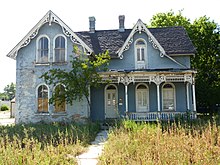User:Kaiguy817/George Taylor, Jr., House
George Taylor House * 187 North 400 West * Provo, Utah[edit]
This house was built in the 1880s. "This house offers an important example of the cross-wing house type in Utah. The cross-wing plan was a predominant form of late nineteenth-century construction. The house also portrays a style reminiscent of the Gothic Revival as evidenced by the laced porch and high-arched windows. These two elements, and the unusual craftsmanship of this home, make the Taylor House one of the best examples of the cross-wing plan in the state. Rounded-arch windows and door openings like those seen here are rare in Provo (Historic Provo p. 7)." This house was designated to the Provo City Landmarks register on August 22, 1995.

Structure[edit]
The George Taylor Jr. House is a one-and-a-half story brick structure on a rubble stone foundation. It is a gable roof, cross wing, vernacular house type with Gothic Revival styling. The cross wing plan is a version of the modified temple plan made popular by the Greek Revival. It was a common plan available to the nineteenth century builder and one propagated through house pattern books to which decorative ornament from any of the prevailing styles was individually or eclectically applied. Carpenter Gothic and Eastlake trim add lacy, intricate ornament to this simple house plan. The house is distinguished as one of only three existing examples in Provo that exhibit the influence of Gothic Revival residential architecture as applied to vernacular house forms. It also has a unique combination of Classical quoins and round arched windows. An addition was made to the back of the house about 1910 and other minor alterations were made during a 1970s restoration project.
This cross wing form house has a gabled wing perpendicular to the main house body. The gable facade is moderately narrow and gives a Gothic feeling of verticality in its two story height with its tall, moderately steeply pitched central pendant. This same decoration is repeated in the center gable of the broadside of the cross wing and its end gable. Both gable ends are pierced by double-hung sash windows are divided by muntins into four lights each. The casing and slipsills are painted white, as is the wooden trim on the rest of the house.
The broadside of the cross-wing is spanned by an elaborate, one story Eastlake porch. A balustrade with turned spindles at the ground level is complemented by an intricate porch freize that is delicately pierced and has short spindles. Squared, chamferred posts, which represent stylized pillars, on panelled pedestals, support the roof. Springing from the pillar abacus are scroll brackets and side brackets with cutout patterns. Pendants mark the termination of the side brackets where they meet the freize. Much of this wooden porchwork and the wooden bargeboard is not original, but it duplicates as nearly as possible the original woodwork which was replaced during the 1970 restoration due to deterioration. Historic photographs were scaled and the existing elements copied to duplicate the original ornamentation.
Round arches with radiating brick voussoirs are also used for the doorways and other windows on the house. The doorways, all identical, are recessed and topped with lunette shaped glass transoms. Each door has four panels, two tall glass panels with round arched heads over two moulded wooden panels. There are three doors in the porch area, one on the side of the gable facade, and two on the broadside of the cross-wing. There is a door centered over the front porch under the center gable, and also a door and window on the side of the house. Brick quoins decorate the corners of the house and overhanging eaves emphasize the roofline.
A one-story rear addition was attached to the house around 1910. It has a boxed cornice with a plain frieze and casement windows. Each side has one window and the rear facade has one door and four windows. The roof of the addition covers a part of a window in an offset gable at the rear of the house. The addition does not detract from the original historic appearance of the house.
References[edit]
- 2002. "Historic Provo" Provo City Landmarks Commission.
- National Park Service. "National Register of Historic Places Inventory -- Nomination Form." April 1995.
- Warnick, Jill Thorley. "Structure/ Site Information Form." Historic Preservation Research office. July 1980.
